Tactile Alphabet Cookies Using Sugar Cookie Playdough
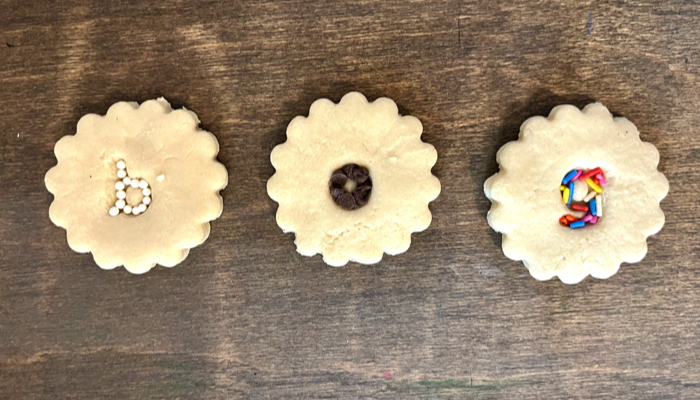
This post may contain affiliate links; please see our terms of use for details.
What child doesn’t love making cookies? From the batter-mixing to the dough-cutting, baking cookies is a fine-motor activity for preschoolers that no one complains about.
My children adore baking cookies, especially if there are toppings involved. Chocolate chips, sprinkles, and candies make cookies more fun. Toppings also make excellent tactile elements for learning.
For this educational activity, I wanted to recreate the same joyous feeling of making cookies. I realized that cookie dough will spoil quickly, but play dough can last for weeks. This is when I came up with a sugar cookie playdough recipe that smells just like the real thing!
If your child loves cookies as much as mine do, they’re sure to jump for joy at this learning activity. These tactile alphabet cookies using sugar cookie playdough are simple to make but provide hours of fun!
Tactile Alphabet Cookies Using Sugar Cookie Playdough: What You’ll Need
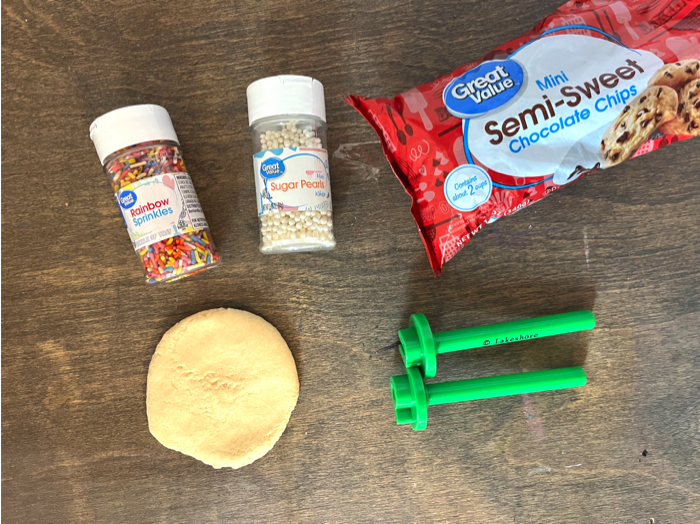
These cookies only use basic ingredients from your pantry.
Playdough ingredients:
- Flour
- Vegetable oil
- Salt
- Water
- Cornstarch
- Vanilla extract
Play Materials:
- Sprinkles
- Chocolate chips
- Cookie cutters
- Rolling pin
- Alphabet dough stampers
How to Make Sugar Cookie Playdough
Before your child can start stamping and creating alphabet cookies, you’ll need to make the playdough. The recipe I created is simple and uses basic ingredients.
Note: I didn’t have cream of tartar in my pantry, so this recipe uses cornstarch as a substitute. We loved how soft it turned out.
Step 1: Combine Dry Ingredients
Combine flour and salt in a mixing bowl. I used all-purpose, unbleached flour, but any flour should do the trick. You can even substitute it for a gluten-free blend if needed.
We like to use pink Himalayan salt in our home. However, I grabbed a bottle of standard table salt for this recipe. No need to use all your high-quality salt here, as you’ll be using quite a bit in the recipe.
Step 2: Add Oil and Vanilla
Add in the vegetable oil and vanilla extract. If you don’t have vegetable oil on hand, any other oil will work. I’ve previously used melted coconut oil and olive oil successfully in this sugar cookie playdough recipe.
Step 3: Add Water
Add warm water so the ingredients mix easily. You don’t need excessively hot water here.
Warm water from the faucet is fine.
Step 4: Mix
Mix all ingredients in the bowl. When the dough starts to form, use your hands to knead it.
Step 5: Add Cornstarch
Add cornstarch to firm up the dough. You’ll want to gradually add it, one tablespoon at a time. Stop adding the cornstarch when the dough no longer sticks to your hands but is soft and pliable.
How to Make Tactile Alphabet Cookies
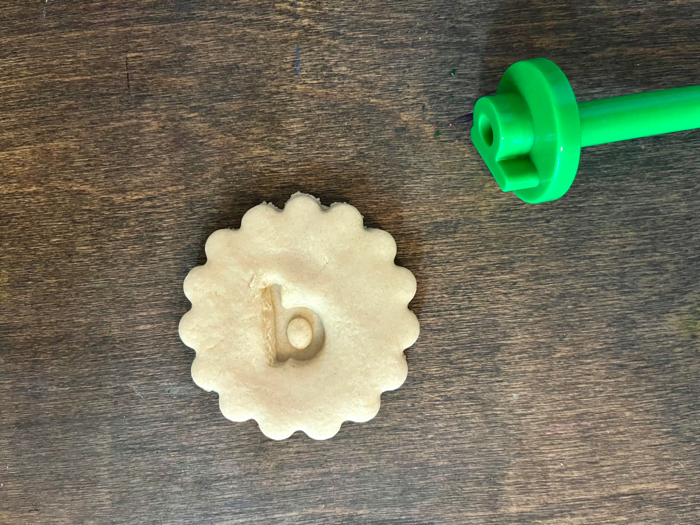
This is the moment your child has been waiting for. It’s time to get those little fingers busy molding the playdough into cookie shapes.
Step 1: Roll Dough
Have your child use a rolling pin to flatten the dough. Offer a variety of cookie cutters for them to use to create cookie shapes.
This is a great time to teach your child how to arrange the cookie cutters to fit multiple shapes in the rolled-out dough. This also serves as a hand-eye coordination game that will strengthen your child’s coordination. Arranging the shapes before cutting provides an opportunity to use problem-solving skills.
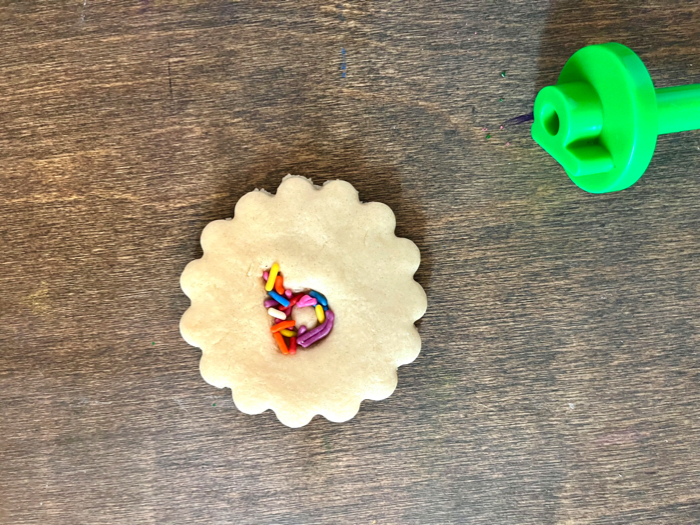
Step 2: Stamp Letters
When the cookies have been cut, give your child a letter stamp to create a letter in the center of each cookie. Encourage your child to feel the shape of the letter on both the stamp and the playdough cookie.
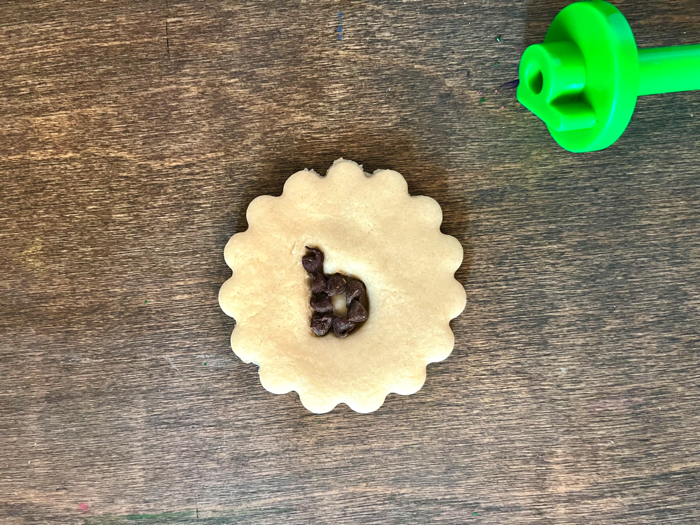
Step 3: Fill with Toppings
Offer your child several toppings to use to fill in the letter shape. We used mini chocolate chips, rainbow sprinkles, and pearl sprinkles. Feel free to experiment with other toppings and find what works best.
Don’t worry if your child mixes the toppings into the playdough, this is part of the fun. My kids ended up mixing it all at the end. It created a fun dough that looked just like cookie dough.
Other Ways to Play
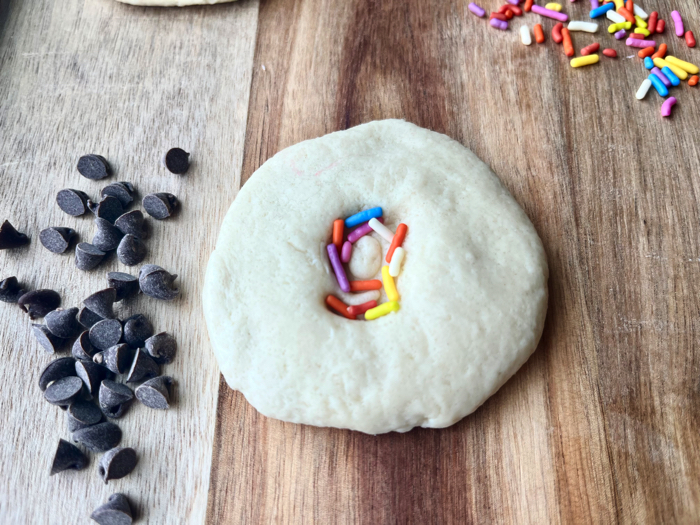
Don’t stop with just letter forming. There are plenty of other ways to continue the learning.
Word Building
Help your child build words with these alphabet cookies using sugar cookie playdough. This would be a fun way to practice sight words, learn to spell their name, or make consonant-vowel-consonant words. Depending on your child’s ability, they can spell the entire word or just fill in the missing letter to a word you spell.
Cutting Skills
After making the cookies, give your child playdough knives and playdough scissors to play with. Learning how to use their fine motor skills to cut and slice are important life skills. These fine motor movements allow them to write, tie their shoes, button up their shirt, and more.
Number Identification
You can also use these cookies to form numbers. If you don’t have number stampers, try forming the numbers using chocolate chips or carving the number into the cookie using a playdough knife.
What else can we add to this playdough activity?
I added a cookie sheet, apron, and oven mitts to this activity. My kids had a blast playing “baker” and creating cookie orders for each other. Pretend play is a crucial part of the stages of play in child development.
What are the benefits of tactile play?
Children are naturally wired for tactile play. If you watch a baby play with a toy, you’ll notice how they immediately touch and taste it. Tactile input activities strengthen a variety of skills needed for healthy child development, including:
Problem-Solving and Decision Making
When a child gets hands-on with playdough, they’ll use their cognitive skills to solve problems that arise. For example, a child might ponder how to push a cookie cutter through thick dough. When that child decides to use a rolling pin or their hands to flatten it first, they’re using problem-solving skills to reach their goal.
Cognitive activities for preschoolers encourage them to come up with solutions and face obstacles with confidence.
Language Skills
When your child holds an object in their hands or touches it with their fingertips, it provides more information about the object. For example, by molding the playdough, they learn that it is soft, warm, and stretchy. You can use tactile play to encourage your child to use descriptive words, which will enrich their vocabulary.
Memory
Learning through the use of multiple senses, rather than just one, will help you to retain more information. When children can see, touch, and hear information, they’re more likely to retain it. These alphabet cookies are the perfect way to help your child memorize their letters quickly.
Calms Emotions
Certain types of tactile play can be soothing for overstimulated children. If you’re wondering how to handle a toddler meltdown or a sensory meltdown, tactile play might be the answer. Sensory boxes, playdough, or other tactile activities will help them shift their attention elsewhere and settle their emotions.
What other ways can I enrich this activity?
- Hardcover Book
- Rau, Dana Meachen (Author)
- English (Publication Language)
- 32 Pages – 07/31/2023 (Publication Date) – Capstone Editions (Publisher)
To make this activity even more exciting, consider adding in one of these activities:
- Read the book Sense of Play by Dana Meachen Rau or any of our favorite tactile books for blind kids
- Discuss braille letters and create them by gluing dry beans on paper
- Draw alphabet letters using chalk on the sidewalk
- Make alphabet pasta for dinner and have your child hunt for letters
Sugar Cookie Playdough
Prep Time: 10 minutes
Ingredients:
- 1 cup flour
- 1/4 cup salt
- 2 tsp vegetable oil
- 1 tsp vanilla
- ½ cup warm water
- 3 Tb cornstarch
Special Equipment:
- Mixing bowl
Instructions:
- In a mixing bowl, combine the flour and salt.
- Add in the vegetable oil and vanilla.
- Pour in warm water and mix until combined.
- Using your hands, knead the dough until all of the ingredients are evenly mixed.
- Add the cornstarch, 1 tablespoon at a time, until the dough is no longer sticky but soft and pliable.
- Roll the playdough into a ball for use. When you’re finished playing, wrap it tightly in saran wrap and store in an airtight container.
- Throw away the playdough when it begins to crumble or harden.
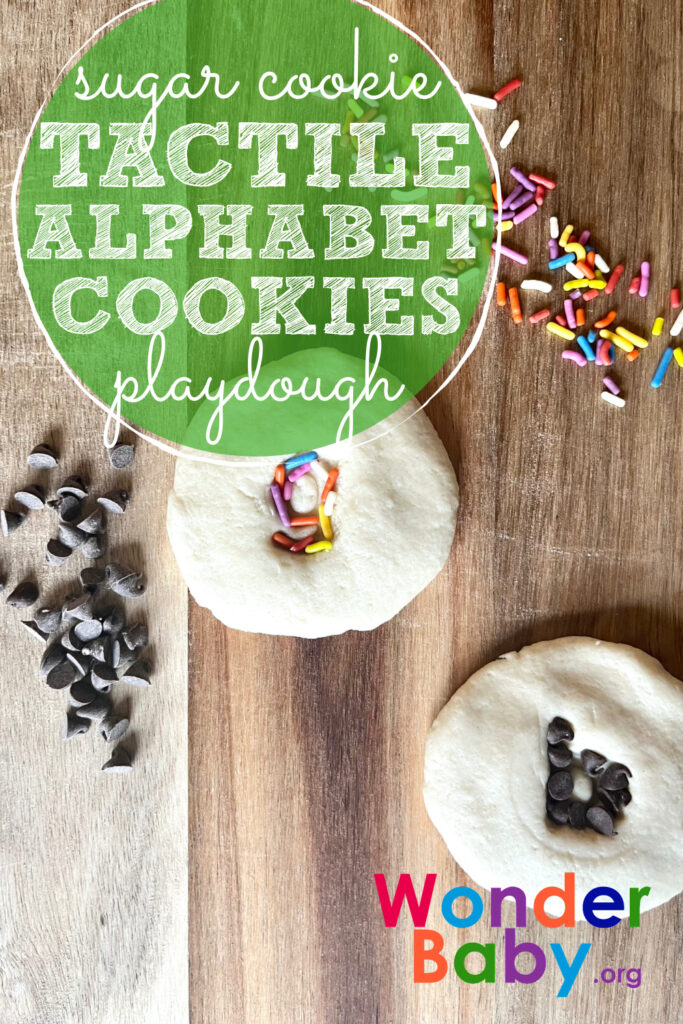
Related Posts

Braille and Literacy, Toys, Visual Impairment
24 Braille Toys for Kids Who are Blind
Everything from alphabet blocks to raised line coloring pages and activity books to puzzles to card and board games... and so much more! And it's all in braille ready for...

Holiday Crafts and Ideas
Should Parents Lie to Their Kids About Santa Claus?
Should parents lie about Santa? Find out how to balance trust, magic, and holiday traditions right here!

Holiday Crafts and Ideas, Special Needs
5 Tips for a Peaceful Thanksgiving with Your Child with Disabilities
Thanksgiving can be a joyful yet overwhelming holiday, especially for families with children who have sensory, motor, or dietary needs.
